

Dylan Valley is a filmmaker from Cape Town who recently completed a master’s degree at the University of Southern California. While in Los Angeles, Valley produced a short documentary film about downtown’s Grand Central Market, and its continuing transformation.
In what’s by default a contrarian gesture these days in L.A., the film, edited in the journalistic style of KCET, allots just twelve minutes or so to explicitly not celebrate the market’s sweeping changes and new vendors, and instead to introduce a few of the hard questions about the market’s role in downtown’s continuing gentrification that risk being swept aside as the ninety-seven year old market receives nominations from Bon Appétit for America's Best New Restaurant 2014.
Valley interviews two generations of an established family business at the market, a local historian, a professor, and one of the new shopkeepers, all representative of what are now archetypal characters in the performance of urban revitalization: the worried small business owners without rent protections, the community representative with less and less community, the fatalist, and the bright-eyed dreamer unwittingly assisting displacement. Considering the history of downtown’s tally of renaissances, Valley’s short presentation is perhaps akin to director Kent Mackenzie’s 1956 film about the then endangered Bunker Hill neighborhood—which he also shot while a student at USC—that attempted to provide a small platform for the soon to be displaced.
I talked with Valley while sitting in Pershing Square on a Friday morning.
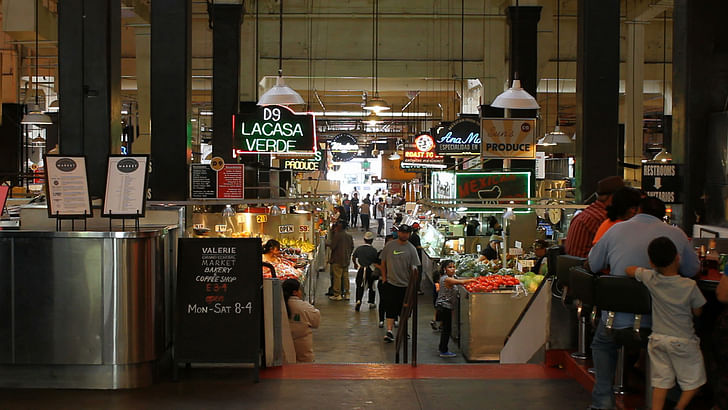
Anthony Carfello: How did you find yourself needing to make a film about the Grand Central Market?
Dylan Valley: I was checking out Angel’s Flight, across the street, and I’d never seen a market like Grand Central in the States. Even in South Africa I don’t see big indoor markets as such. Immediately, I noticed this mixture of working class businesses alongside these kinds of high-end, boutique foodie stores. I couldn’t really make sense of the mix. I read up about the market’s history, and thought this is an interesting version of gentrification because in Cape Town they’ll just buy a whole building and evict everybody, just being very clear that you have to leave. That’s happened a lot in the neighborhood I live in.
I noticed this mixture of working class businesses alongside these kinds of high-end, boutique foodie stores. I couldn’t really make sense of the mix.Grand Central was odd for me, because it certainly seemed like gentrification, but somehow more inclusive, with everybody as one big, happy family. I thought that could make an interesting movie. And I initially felt very positive about it, about what they were doing. When I actually started speaking to people, however, and going around getting to know the tenants, I realized that this is a long-term project of the owners of the market to totally transform the place.
Who were the first market locals that you started speaking with?
Actually the people in the film, particularly Rocio Lopez. I had read an op-ed by Steve Lopez in the Los Angeles Times about the market and his worries about the changes, and she was quoted speaking about her family’s ties to the market. Her story interested me and I met her right away.
Was she one of the people that made you realize there was actually a different urgency going on there?
Yes, she definitely helped me to understand what the older tenants were facing. Her niece was in the film, Claudia, and I met her soon after. She rather liked what was going on, the new places coming in, even while understanding the immediate threat to their business.

I remember. In the film, she was a good representation of how these issues can quickly become complex, especially when one thinks about how they consume in the market.
I get how she feels. If I’m to be totally honest—maybe not optimistic, but honest—I like G&B’s coffee. And I like the sandwiches at Eggslut. These amenities are attractive to me, and people like me, students and scholars, you know. It’s complicated—I think a lot of people who are writing about gentrification and studying it may feel the same way, they also like the coffee, or at least understand how others would. I was trying to move past that though to consider, or at least to begin to consider, these foods and choices for their class implications, simultaneous with one’s personal preferences. These are all small businesses, like DTLA Cheese, and that’s certainly preferable to global chains, but who are these small businesses for?
What do you think is one of the biggest things at stake with that market, if it were to become all artisanal luxury shops?
I’d say it’s like Isabel Castro says in the film: Los Angeles is gonna lose a piece of its history. It’s gonna lose a piece of culture that makes it uniquely Los Angeles. In that same Times article, Lopez mentions that developers from the Ferry Building in San Francisco have consulted owners of Grand Central, and he makes the necessary point of how, well, dull and bourgeois the place is... And so, I imagine that this is what it’s gonna look like eventually.
Yes, some new places are going to serve great food, but I don't think that there’s anything particularly culturally specific to Los Angeles about them—the market won’t keep that kind of Angeleno diversity.
I think a lot of people who are writing about gentrification and studying it may feel the same way, they also like the coffee, or at least understand how others would.One thinks of the way globalization tends to erase difference, and people buy into this idea that they want to see the same things wherever they go. If you go to Cape Town, there's actually a market—though it’s not a permanent structure, it’s in a warehouse but only on Saturdays—with the same kind of food that’s coming up at Grand Central now. And it’s happening everywhere. It’s kind of sad to lose elements of an historic local culture—just being able to interact with people who have history in that space, have been business owners for decades, and hearing their stories, getting to know the stories of L.A. through these shop owners.
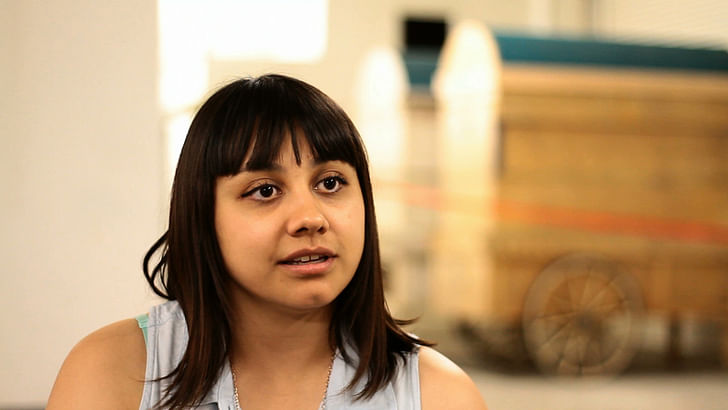
What’s your thinking about the role of documentary practice at a place like this where changes are well underway?
It’s to present the current condition. Once I started talking to people, it was very clear that the market wasn’t going to stay even as I found it. That mix that caught my attention will soon be gone, and it’s important, I think, to document these kinds of moments, to take action in some way.
Again, however much we enjoy the products of the new places, I don’t think that goes in front of a duty to bear witness to immediate histories and report what’s going on, report on those forces of displacement and who they impact.
Left up to market forces, something like that will never stay. It will always tip one way or the other, usually in the favor of capital, either investment or withdrawal. And there’s a face to that process in the people who are being move out. Since I finished, I heard that Jose’s Ice Cream Corner is gone now. In the interview with Rocio, she says they’re now on a month-to-month rental rather than a solid lease.
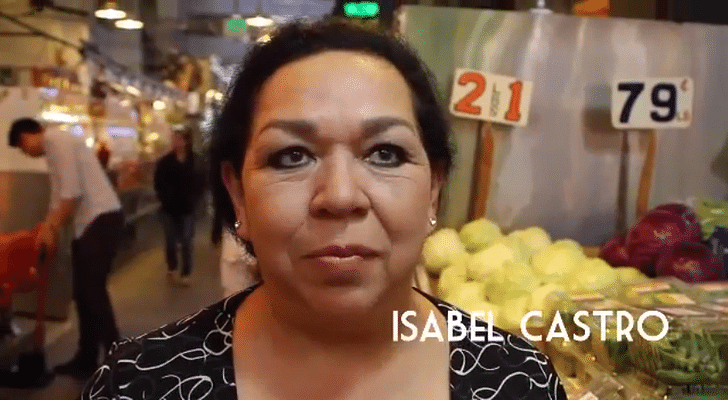
In Cape Town, when a building is changed as you described earlier, is there an instant kind of change that happens versus Grand Central’s kind of thing where it’s sort of a slower transition?
It’s a lot quicker there. And it’s like definitely this quick shift from black to white. In South Africa, especially in Cape Town, there isn’t a big black middle class. The middle class people in creative industries are mostly white. And so it’s this change where all of a sudden you can go to a restaurant, and be the only person of color in there.
Los Angeles is gonna lose a piece of its history. It’s gonna lose a piece of culture that makes it uniquely Los Angeles.This is happening now with the gentrification of a neighborhood called Woodstock, which is just east of the center of downtown Cape Town. It’s interesting because it’s always been a gray zone, even under apartheid.
People of color were moved outside of the city in those years, like way out, into the townships. They were far away, specifically, from the beauty of Cape Town, between the mountains and the sea, et cetera. But there was this area just beside the center of town, where people always kind of met, and somehow managed to live close to each other throughout. And I think it had to do with the demolition of the neighborhood right next to that in the 1970s, called District Six, a different multicultural neighborhood that they bulldozed and totally demolished—they were supposed to rebuild it as a white neighborhood, but they never did. It’s still there today, just grasslands next to downtown Cape Town. People never forgot that, and Woodstock stayed the way it was, an area where most of the population is and has been mixed race.
Nowadays, the city is expanding east, as Cape Town’s adopted the same neoliberal principles the whole country did in the ‘90s—we're seeing it in full effect now. For example, there used to be an artist space, studios and all that, and then they were bought out. Now it’s called the Woodstock Exchange, and it’s all boutique stores, cafes, and high-end little office spaces. It was all a very, very quick process—they just bought the building and changed it overnight and everyone there before was gone.
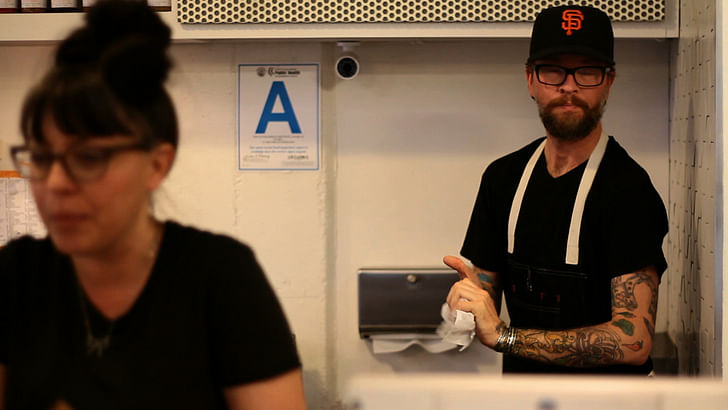
And then there's the Old Biscuit Mill, which, well, used to be a biscuit mill... that’s different because there wasn’t a displacement of people per se, but it’s in the middle of a very working class, low-income neighborhood in Woodstock, and it’s a kind of fancy, temporary retail space. On Saturdays, they have the market there—kind of like Grand Central, foodie places and such It’s just about aesthetic... the aesthetic of a cultural hybridity without actually having, you know, the hybridity of the population, economically or racially.like I mentioned earlier—but it’s a stark contrast to the normal neighborhood, a very visible difference, particularly in terms of race. When the market’s on, you see white people that are normally never in this non-white neighborhood: they won’t come during the week. Mostly, the press coverage has been that the mill is a good thing because one brings their money into Woodstock. We get to see Porsches driving down the road and that kind of thing.
Are people actually going to the surrounding businesses and spreading that money around? Or, are they just going to the market, consuming and leaving? No one asks that.
People just care that Cape Town is becoming a kind of cool city, they’re just excited that Mos Def lives there now. I think he’s kind of opening a window for a lot of people who are like, “Oh, we can do this? We can just move there?” It’s going through a major transformation, also because of the World Cup four years ago. So, we’ll see...
Has the Old Biscuit Mill affected real estate prices nearby?
Oh yeah, the rents have gone up and a lot of people are unable to stay. It’s amazing that snowball effect. I guess it’s the same with the ‘brownstoners’ in Brooklyn, this initial mentality or catalyst action that ends up exponentially mimicked.
Yeah, have you seen the film My Brooklyn by Kelly Anderson?
Only the trailer.
The filmmakers show the hyper-development of the Fulton Mall area—shown to be like the heart or town square of Brooklyn in the ‘80s and ‘90s—as indicative of the larger trends in the borough. At one point, a white woman in a posh neighborhood nearby is asked her thoughts on Fulton Mall, and sums it up, “I like the concept of the Mall, I just haven’t been there.” I thought of this in watching your film and reaching out to you. I’ve watched people interact with Grand Central Market the same way.
It’s just about aesthetic... I think that that’s the thing that will be in these places now, the aesthetic of a cultural hybridity without actually having, you know, the hybridity of the population, economically or racially. So, one gets to be satisfied with the idea that they’re in this dynamic, multicultural space but without that authenticity they supposedly sought. At Grand Central, you can think of it like keeping that China Cafe neon sign without the actual cheap Chinese diner food, keep the sign but have it hanging over some new upscale spot.
I wouldn’t be surprised to see that eventually. That’s the whole thesis in Sharon Zukin’s Naked City, that the middle class comes in yearning for some abstract urban authenticity and prices out the population that produced all that local culture... the place just becomes a stage set of what it once was.
What do you think the people facing displacement can do?
There's people sitting in boardrooms who have long-term plans for neighborhoods and for increasing the return on their investments. It’s not just some kind of organic economic processI’ve never seen anybody resist and win, so I’m not sure. I think some form of solidarity and organizational support, people getting together and kind of pushing for policy change, is the place to begin. I know in some states in the U.S. you have rent controls, which are really important. I think people need to stand in solidarity with people who are facing displacement, and try and think of ways to try and stop this kind of thing from happening. As well, if you're facing displacement, I think it’s first necessary to become educated about these processes. Then one can figure out ways to work with other people facing the same issues, and after start making some noise about it.
Before this whole project, I knew, generally, what gentrification was, but I have a much better understanding of it now. I thought it was something that was inevitable, just part of a cycle, you know. But there are people planning this kind of thing. There's people sitting in boardrooms who have long-term plans for neighborhoods and for increasing the return on their investments. It’s not just some kind of organic economic process, L.A. city officials have been planning a regeneration of downtown for decades.
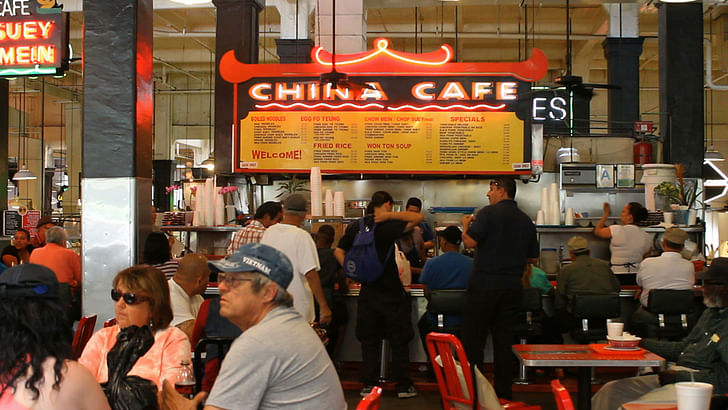
They’re obsessed with downtown.
*Purple shirt guys ride past us on bikes*
Do you know the Purple Patrol, the guys driving around in purple polo shirts?
I’ve noticed them but I thought they were just the police, no?
No, they're private. They’re hired by the Business Improvement District to ride around and harass the homeless. Mostly, they incite, and then call the LAPD, which makes people want to move away from them, thus clearing the area for middle class people living, working, and playing.
That’s so weird.
This version of downtown’s revival really took off after the Adaptive Reuse Ordinance in 1999, which made it easy to convert old buildings into housing. But, it started on certain streets more than others, and then has just slowly spread from block to block to other streets, now having Skid Row surrounded, so to say.
Yeah, and even though people are so keen on hanging out downtown, they’ll still stay to a particular version of downtown, and not engage in anything else until they’re told it’s safe and fun.
3 Comments
excellent!
Well done on a very complicated issue
Not complex. Plain gentrification. Patronizing, hungry for culture (usually the ones they can colonize) homogeneous hipsteryuppies at work. Manhattanization of LA is underway. We have riots and earthquakes tho.
Block this user
Are you sure you want to block this user and hide all related comments throughout the site?
Archinect
This is your first comment on Archinect. Your comment will be visible once approved.